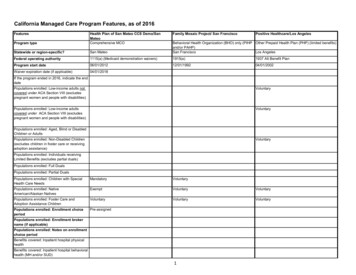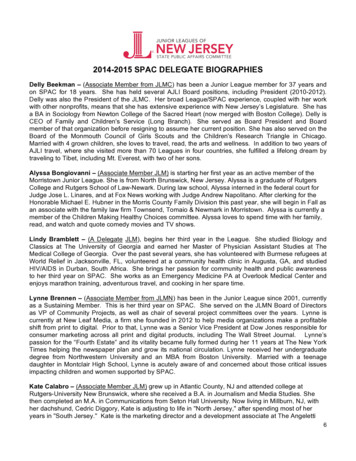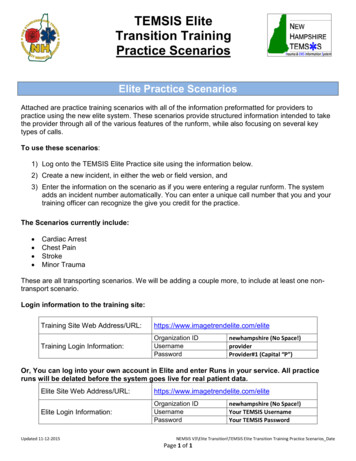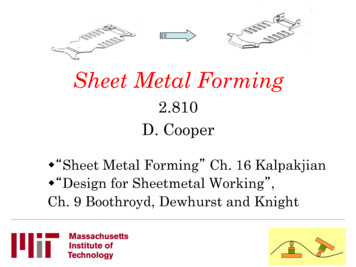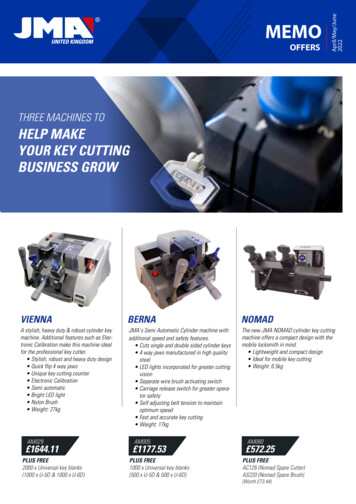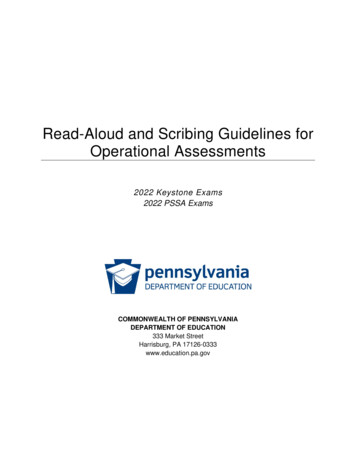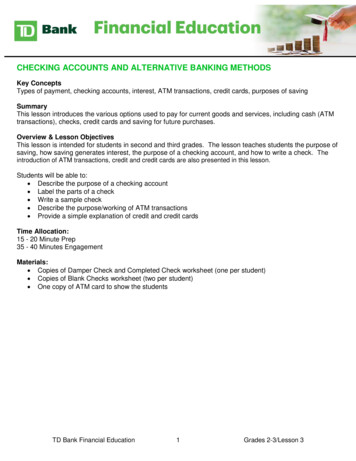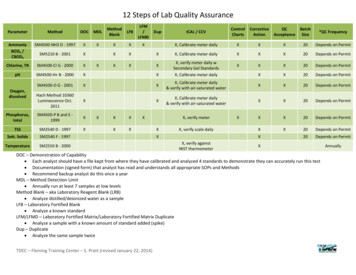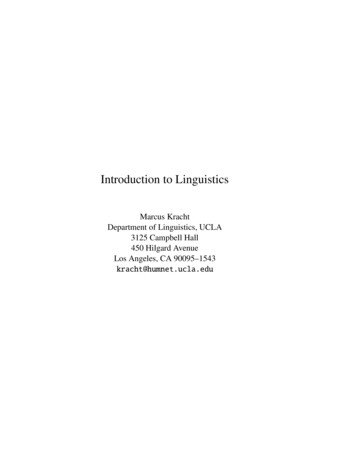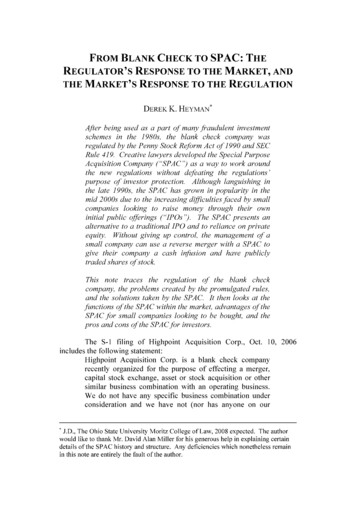
Transcription
FROM BLANK CHECK TO SPAC: THEREGULATOR'S RESPONSE TO THE MARKET, ANDTHE MARKET'S RESPONSE TO THE REGULATIONDEREK K. HEYMAN*After being used as a part of many fraudulent investmentschemes in the 1980s, the blank check company wasregulated by the Penny Stock Reform Act of 1990 and SECRule 419. Creative lawyers developed the Special PurposeAcquisition Company ("SPAC') as a way to work aroundthe new regulations without defeating the regulations'purpose of investor protection. Although languishing inthe late 1990s, the SPAC has grown in popularity in themid 2000s due to the increasingdifficulties faced by smallcompanies looking to raise money through their owninitialpublic offerings ("IPOs'). The SPAC presents analternative to a traditionalIPO and to reliance on privateequity. Without giving up control, the management of asmall company can use a reverse merger with a SPAC togive their company a cash infusion and have publiclytradedshares of stock.This note traces the regulation of the blank checkcompany, the problems created by the promulgated rules,and the solutions taken by the SPAC. It then looks at thefunctions of the SPAC within the market, advantages of theSPAC for small companies looking to be bought, and thepros and cons of the SPAC for investors.The S-1 filing of Highpoint Acquisition Corp., Oct. 10, 2006includes the following statement:Highpoint Acquisition Corp. is a blank check companyrecently organized for the purpose of effecting a merger,capital stock exchange, asset or stock acquisition or othersimilar business combination with an operating business.We do not have any specific business combination underconsideration and we have not (nor has anyone on ourJ.D., The Ohio State University Moritz College of Law, 2008 expected. The authorwould like to thank Mr. David Alan Miller for his generous help in explaining certaindetails of the SPAC history and structure. Any deficiencies which nonetheless remainin this note are entirely the fault of the author.
532ENTREPRENEURIAL BUSINESS LA WJOURNAL[Vol. 2:1behalf) contacted any prospective target business or hadany discussions, formal or otherwise, with respect to such atransaction. Our efforts in identifying a prospective targetbusiness will not be limited to a particular industry,although we intend to focus initially on target businesses inthe healthcare industry.'This statement is typical of the SPAC, 2 a new vehicle for raising money inthe public capital markets. Does investing in a company with no assets andwhose only business plan is to purchase an as-yet unknown company soundrisky? It may seem even more so after looking at the shady history of the"blank check" company, of which the SPAC is a modern form. Suchcompanies are "shells" that raise money via an initial public offering("IPO"), with the stated purpose of merging with an operating company.While it is true that in the 1980s, these companies were frequent vehiclesfor defrauding unsophisticated investors, the modern SPAC is a postregulation vehicle with many built-in safety features. Its primary investorsare among the most sophisticated-hedge funds-and it appears to havetaken its place at the table of legitimate means of raising capital.Some regulators would have preferred to keep the blank check, inany form, away from the table altogether. In the hearings related to theSecurities Enforcement Remedies and Penny Stock Reform Act of 1990("PSRA"), the U.S. Attorney for the District of Utah stated with regard toblank check initial public offerings, "[w]e find no evidence that these3offerings provide any benefit to the U.S. economy or capital formation.,Due to the passage of this federal legislation, as well as the strict regulationby Utah and many other states, the number of blank check offerings greatlydiminished after the 1980s. There were approximately 2,700 blank checkofferings during the Security and Exchange Commission's ("SEC" or the"Commission") 1987-1990 combined fiscal years; 4 in the early 1990s, therewere fewer than fifteen. In 1992, the SPAC was developed by a small teamof lawyers and underwriters to create a form of blank check companywithsufficient investor protection in place to gain the approval of the SEC. TheSPAC will be discussed at length in this note, but in the mid to late 1990s,these vehicles faded from the scene, not because of problems with theirstructure, but due to market conditions: it was easy during this time forsmall companies to raise money in traditional IPOs.5 However, in 2003,activity began to pick up and during the mid-2000s-a period of decline inthe number of IPO's generally in the U.S. capital markets-blank checkHighpoint Acquisition Corp., Amendment No. 2 to Registration Statement (Form SI/A)(Feb. 2, 2007).2 The original name for these entities is "Specified Purpose Acquisition Company," butspecial appears to have replaced specified in most recent publications.H.R. REP. No. 101-617 (1990), as reprintedin 1990 U.S.C.C.A.N. 1408, 1424.4 William M. Prifti, 24 SEC. PUB. & PRIV. OFFERINGS § 7:48 (2006).5 Eric J. Savitz, The New Blind Pools, BARRON'S, Dec. 12, 2005, at 21.
2007]FROM BLANK CHECK TO SPACofferings, in the form of SPACs, have exhibited a clear growth trend. In2004, there were twelve issues raising 0.44 billion; in 2005, there weretwenty-nine issues raising 2.06 billion;6 and in 2006, there were thirtyseven, raising almost 2.7 billion.This note discusses the regulations that went into effect in 1993 tocurb the abuses relating to blank check companies without outlawing thementirely. It also shows how creative lawyering, in cooperation with theSEC, brought into being the legitimate investment vehicle known as theSPAC. The SPAC, while technically exempt from blank check regulation,is modeled on these regulations as a way of ensuring that its structureretains the SEC's approval. The note also evaluates the SPAC in terms ofwhy it is useful to companies looking to raise capital, to investors, and tothe managers of this contemporary form of a blank check company.I. WHAT IS A BLANK CHECK OFFERING?Before discussing the SPAC, it is necessary to look at theregulatory framework put in place to control the traditional blank checkcompany. A blank check offering is an initial public offering of a companythat has been formed for the purpose of raising money and buying analready existing company. It is allowed to offer "penny stock" S for thispurpose, but is subject to significant regulation. These regulations are sostringent that they not only removed the usefulness of the blank check as avehicle for the "pump and dump" schemes of the 1980s, but also made thevehicle unattractive for most legitimate capital raising activity. The PSRA,inter alia, added § 77g to the Securities Act of 1933, and defined "blankcheck company" as follows:[T]he term "blank check company" means any developmentstage company that is issuing a penny stock (within themeaning of section 78c(a)(51) of this title) and that(A) has no specific business plan or purpose; or(B) has indicated that its business plan is to merge with anunidentified company or companies. 9Section 77g(b)(1) also requires the SEC to "prescribe special ruleswith respect to registration statements filed by any issuer that is a blankcheck company."' 0 This statute led to SEC Rule 419, to be discussed infraat pages 538-39. Since the blank check company has no hard assets, noreven a specific business plan at the time of its offering, other than perhaps acertain industry or geographical region in which it plans to make its6 Street Scene; Back of the Envelope, N.Y. TIMES, Sept. 8, 2006, at C6.7 YungKim, US Companies FindAlternate Route to Public Market, REUTERSDec. 21, 2006.8 Penny stock is stock offered for sale for less than 5 per share.9 15 U.S.C. § 77g(b)(3) (2006).'o15 U.S.C. § 77g(b)(1) (2006).NEWS,
534ENTREPRENEURIAL BUSINESS LA WJOURNAL[Vol. 2:1purchase, investors are essentially "betting on the jockey"-the expertise ofthe managers who have formed the company.' In fact, the managementteam is often made up of high profile names that are likely to attractinvestment.The blank check offering should be distinguished from a "blindpool" offering. While in some states' regulatory schemes-and in somemedia reports-the two are not distinguished, SEC Rule 419 (whichimplemented the 1990 reforms) regards blind pools as having enough1specificity in their business plans to fall outside the rule's requirements. 2The blind pool, to be sure, is similar to the blank check in that it raisesfunds to purchase unidentified assets. However, the blind pool is actually alimited partnership or other direct participation program with a specificbusiness plan,' 3 for instance, to use the SEC's own example, a "real estatelimited partnership formed to invest in apartment buildings that have not yetbeen selected. 1 4 The blank check is, after the IPO, a public company, andyet has still less specificity in its plan. Thus, it is subject to more stringentstructural requirements for the protection of investors. Primary amongthese is the fact that at least 85% of the IPO proceeds must be kept in anescrow or trust account, invested in low-risk government securities, untilthe purchase is made. Additionally, the number of investors who maydisapprove of the purchase when proposed is limited to 20% (if thepurchase is to go forward), and the company has only eighteen months fromthe date of the IPO to make its purchase, plus a six month grace period if adeal is announced but not completed by the end of the first eighteenmonths.1 5II. BLANK CHECKS' CHECKERED PASTThe purpose of the strict regulation of blank check offerings, aswith all regulation, is to curb abuse. The new blank check statute was partof the PSRA. To understand the law and implementing regulations, it ishelpful to understand the situation in the late 1980s. Penny stocks were anarea fraught with serious abuse, 16 and blank checks were a common way in11Karen Richardson & Peter Lattman, FinanciersNow Say 'Trust Us'Blank-Check Offerings of Yore, SPAC Investors are Asked to Buy inLike theon Faith,WALL ST. J., Feb. 1, 2007, at Cl.12STUART R. COHN, 2 S.E.C. COUNSELING FOR SMALL & EMERGING COMPANIES § 19:19(2006). The SPAC too falls outside these requirements, but for different reasons. Seeinfra Section IV.13Blank Check Offerings, Securities Act Release No. 33-6932, 51 SEC Docket 284(Apr. 13, 1992).14id.15Savitz, supra note 5, at 21.16The SEC reports that in fiscal 1988, 12 .5 % of all substantive broker-dealercomplaints involved penny stock firms. In 1989, the figure had become 22%. This wasdespite the fact that penny stock brokers at this time constituted less than 50% of the
2007]FROM BLANK CHECK TO SPACwhich fraudulent activity was carried out. 1 7 Penny stocks were notregistered or approved for registration and were not traded on a nationalsecurities exchange. 18 Therefore, they were not subject to regulation priorto the Act. Falling below the SEC's radar and even that of state regulators,they were easily used to manipulate the expectations of unwary individualinvestors. There were many schemes in which, for instance, broker-dealersoperating in a "boiler room" environment, would cold-call potentialinvestors, sell them stocks at inflated prices, and profit from the differencebetween the mark-up and the actual trading price. In typical legitimatebroker-dealer activity, by contrast, the profit comes from a commission. Asthe legislative history of the Act states:A common method of perpetrating penny stockfraud is through the marketing of "shell" corporations, or"blank check companies" with no operating history, fewemployees, few or no discernible assets, and no legitimatelikelihood of success in the future. Often the only legallystated purpose of such companies is to seek investmentopportunities through mergers and acquisitions.19When used in these fraudulent schemes, the blank check offerings wereoften bought by a collection of friendly brokerage firms or clients, whowould then, in collusion, maintain control of the market. Prices were easilymanipulated, so that investors could be roped in with a chance to get in onthe ground floor. As the blank check company announced its purchase, thesalespeople were able to generate great excitement about the company.However, unsuspecting buyers of the stock might be surprised to find that,when they went to cash out of their stock, there was no market available tobuy it. The stock was in fact worthless.20In 1990, penny stocks and blank check companies were truly anarea in need of regulation, and the state and federal regulations that wentinto place accomplished the intended effect of greatly diminishing theabusive practices.2Although thirty-six states completely prohibited orregistered broker dealers in the country. H.R. Rep. 101-617 (1990), as reprinted in1990 U.S.C.C.A.N. 1408, 1411-12.17The North American Security Administrators Association estimated that, in 1988alone, public investors lost more than 2 billion in penny stock schemes. Gerald V.Niesar & David M. Niebauer, The Small Public Company after the Penny Stock ReformAct of 1990, 20 SEC. REG. L.J. 227, 239 (1992).18 See the definition of "penny stock" at 15 U.S.C. § 78c(a)(51)(A) (2006).19 H.R. REP. No. 101-617 (1990), as reprintedin 1990 U.S.C.C.A.N. 1408, 1413.20 Id. at 1414.21Randolph Beatty & Padma Kadiyala, Impact of the Penny Stock Reform Actof 1990on the Initial Public Offering Market, 46 J.L. & ECON. 517, 518 (2003), have disputedthe success of the PSRA in curbing speculative IPOs. However, although their resultsshow that speculative IPO activity continued after the Act, this does not imply thatabusive practices were not in fact reined in by the Act.
536ENTREPRENEURIAL BUSINESS LA WJOURNAL[Vol. 2:1substantially restricted blank check companies 22 and the federal statuteadded substantial limitations, blank check companies were not outlawedentirely. This is because, despite the blank check's extensive use withinfraudulent schemes, then SEC Chairman Richard Breeden and NASDenforcement director John Pinto agreed that "blank check offerings could beand were used in legitimate business transactions outside the penny stockarea." 23 Congress and some of the states chose to adopt the SEC'straditional approach of solving problems through requiring disclosure, inthe belief that "sunlight," as "the best of disinfectants, 24 would clear up theproblem. What is most interesting is not that the problem was in factlargely cleared up, but that the basic concept of the blank check, like themythical Phoenix, has risen from the ashes of its past. While deviatingstructurally in only minor ways from the House Committee Report'sdescription, the new blank check offering is now a significant source offinancing, many underwritten by major banks such as Citigroup andDeutche Bank. In the form of the SPAC, they have lately been a growingniche in the U.S. IPO market.III. WHAT THE CURRENT RULES REQUIREThe PSRA stated, at finding (8): "The present regulatoryenvironment has permitted the ascendancy of the use of particular marketpractices, such as 'reverse mergers,' with shell corporations and 'blankcheck' offerings, which are used to facilitate manipulation schemes andharm investors. 2 5 To combat these abuses, the environment was changedthrough regulating the penny stock market generally, for instance, throughrequiring an automated listing system to replace or at least supplement the26unregulated "pink sheets" that were investors' only source of information,and by regulating blank check offerings specifically. As to the former, thelaw requires that an automated quotation system be set up for the trading ofpenny stocks, removing them from the realm of easily manipulated pinksheet listings. As to the latter, the Act added section (b) to section 7 of theSecurities Act of 1933.27 This section of the Securities Act defined blankcheck companies for purposes of the Act. In arriving at this definition,22H.R. REP.No. 101-617 (1990), as reprintedin 1990 U.S.C.C.A.N. 1408, 1420.23 Id at 1424.24 Robert B. Stevenson, Jr., The S.E.C. and the New Disclosure, 62 CORNELL L. REv.50, 52 (1976) (quoting Brandeis, J.).25PSRA, Pub. L. No. 101-429, 104 Stat. 931, 951 (1990).26According to the PSRA's legislative history, the pink sheets published the prices atwhich a dealer was willing to buy and sell specific stocks. The dealer "need onlyprovide a minimal amount of information about the listing company," and "is notlegally responsible for the accuracy of the information provided." H.R. REP. No. 101617 (1990), as reprintedin 1990 U.S.C.C.A.N. 1408, 1410.2715 U.S.C. § 77(g) (2006).
2007]FROM BLANK CHECK TO SPACCongress clearly had in mind those shell companies that were used soeffectively to fool investors into thinking they were investing in a growthopportunity when in fact they were investing in next to nothing. And yet,emptiness is a container holding the potential for growth. Holding to thepresumption that the legitimate use of the blank check vehicle was possibleso long as disclosure kept investors out of the darkness, subsection (b)(1) ofthe Act provides a framework for regulation. Subsection (b)(1)(A) requires"timely disclosure . . . of (i) information regarding the company to beacquired and the specific application of the proceeds of the offering, or (ii)additional information necessary to prevent such statement from beingmisleading." The disclosure rules would be supplemented by investorprotection rules. Section (b)(1)(B) places "limitations on the use of suchproceeds and the distribution of securities by such issuer until thedisclosures required under subparagraph (A) have been made." Finally,(b)(1)(C) "provide[s] a right of rescission to shareholders of suchsecurities. ,,28The definition of penny stock is contained in § 3(a)(51) of theSecurities Act of 1934 (as amended). 29 This section is meant to track the"designated security" definition from the SEC's Rule 15c2-6, whichregulated "cold-calling," the high pressure telephone sales tactics that wereone aspect of the boiler room schemes that used penny stocks and blankcheck companies to defraud unsophisticated investors. This section of thestatute defines the term by excluding securities that were consideredsufficiently safe via regulation by either the SEC or the national exchanges.Thus, § 3(a)(51) states:The term "penny stock" means any equity security otherthan a security that is(i) registered or approved for registration and traded on anational securities exchange that meets such criteria as theCommission shall prescribe by rule or regulation forpurposes of this paragraph;(ii) authorized for quotation on an automated quotationsystem sponsored by a registered securities association, ifsuch system (I) was established and in operation beforeJanuary 1, 1990, and (ii) meets such criteria as theCommission shall prescribe by rule or regulation forpurposes of this paragraph;21Id.A right of rescission means, in this context, that the shareholders, if a merger dealis never consummated, may turn in their shares for a proportional share of the assets ofthe blank check company - the money remaining in the escrow account.29Securities Act of 1934, § 3(a)(51) (codified as amended at 15 U.S.C. § 78c(a)(51)(A)(2006)).30 Niesar & Niebauer, supra note 17, at 248.
538ENTREPRENEURIAL BUSINESS LAWJOURNAL[Vol. 2:1(iii) issued by an investment company registered under theInvestment Company Act of 1940 [15 U.S.C. § 80a-1 etseq.];(iv) excluded, on the basis of exceeding a minimum price,net tangible assets of the issuer, or other relevant criteria,from the definition of such term by rule or regulation whichthe Commission shall prescribe for purposes of thisparagraph; or(v) exempted, in whole or part, conditionally orunconditionally, from the definition of such term by rule,regulation, or order prescribed by the Commission.31Exclusion (iv) is particularly important, as it allows an issuer to avoid beingclassified as a penny stock, either through a minimum price of 5.00 orhigher, or through ensuring that its post-offering net tangible assets will begreater than 5 million. The use of the second option under this exclusionby the modern day SPAC will be discussed later.The blank check offering portion of the PSRA was implementedand fleshed out by SEC Rule 419,32 which was designed with the dualpurpose of placing strict controls on the proceeds of the blank checkoffering, and giving investors a chance to reconsider their investment withthe knowledge of all the facts of the company, including its acquisitiontarget.33 The six principal provisions are:(1) the requirement that IPO proceeds, net of cash paid for underwritingcommissions, underwriting expenses and dealer allowances, and the tenpercent allowed to the registrant, be kept in an escrow account, where theymust remain until the purchase is approved.34 This escrow account must beeither (a) an insured depository institution or (b) a separate bank accounthaving a broker or dealer with net capital of at least 25,000 acting astrustee.(2) A post-effective amendment is required at such time as a targetcompany is identified as a probable acquisition. This amendment mustinclude the financial statements of the registrant and the target, and proforma financial information as required by applicable rules and regulations.Because warrants-options to buy shares at a set price-are generallyissued with the stock as part of the blank check IPO, Rule 419 implies acontinuous offering of the underlying security.3 53115 U.S.C. § 78c(a)(51)(A) (2006). The implementing regulations, which wereupdated in 2005, may be found at 17 C.F.R. § 240.3a51-1 (2007).32 17 C.F.R. § 230.419 (2007).33Stuart R. Cohn, 2 S.E.C. COUNSELING FOR SMALL & EMERGING COMPANIES § 19:19(2006).34 17 C.F.R. § 230.419(b) (2007).35 17 C.F.R. § 230.419(d) (2007). The offering is continuous because when thewarrants are exercised, additional stock must be issued to the exerciser. Sinceoutstanding warrants imply that there is additional stock that has not yet been issued,
2007]FROM BLANK CHECK TO SPAC(3) Another post-effective amendment to the registration statement must befiled when the company executes its acquisition agreement. The purchasersmust be sent the prospectus contained in this amendment, and are givenbetween twenty and forty-five business days from the effective date of thisamendment to notify the registrant whether they intend to remain aninvestor.3 6(4) If purchaser chooses not to remain, he or she is given rescission rights asto purchaser's investment, plus interest, less certain expenses. 37(5) Restrictions on the release of the offering proceeds from escrow untilthe purchase conditions have been met, including the condition that thepurchase must use at least 80% of the funds raised, both at the IPO andthrough conversion of the warrants, but not including the amount payable tonon-affiliates for underwriting commissions and expenses, and dealerallowances.38(6) An eighteen month time limit in which the company must buy a targetor return the money to the investors.39Essentially, these restrictions provide substantial protections toinvestors, largely putting an end to the use of the blank check company as avehicle for fraud. 40 The occasional case is still heard in which shellcompanies are used for blatant market manipulation, 4 1 but this is minimalcompared with the situation in the 1980s; it can safely be said that theregulations stemming from the PSRA have been largely successful incurbing abuse.4 2IV. MOVE TO LEGITIMACY: THE SPACthe SEC recognizes that the original prospectus may become outdated before all stock isissued. Therefore, the Commission requires the filing of updates in the form of posteffective amendments to the registration statement. See Harold S. Bloomenthal &Samuel Wolff, 3B SEC. & FED. CORP. LAW § 9.27 (2d ed.).36 17 C.F.R. § 230.419(e)(2)(ii) (2007).37 The fees and expenses range from 8 to 15% of the total. Scott Malone, IPO VIEWCrunch Time Comingfor Blank-Check Companies, REUTERS NEWS, Mar. 26, 2006.3817 C.F.R. § 230.419(e)(1) (2007).39 17 C.F.R. § 230.419(e)(2)(iv) (2007).40 But see Press Release, NASD (Aug. 14, 1997), available at sReleases/NASDW 010512 (discussing a sanctiongiven to GKN Securities, an early SPAC underwriter, and twenty-nine additionalbrokers for aftermarket manipulation of eight securities it underwrote, including fourthat were SPACs). See also Savitz, supra note 5, at 21.41 S.E.C. v. Kern, 425 F.3d 143 (2d Cir. 2005). The defendant in this case did not workaround the regulations; he blatantly disregarded them.42 Note that in 1992, in the period between passage the PSRA and the promulgationofRule 419, it looked as if the penny stock abuses were beginning to make a comeback,with many of the same players returning to business under new names. Dean Foust,The Penny-Stock Boys are Back, BUSINESS WEEK, Jul. 20, 1992, at 76. But the abusesdo not appear to have continued to any significant extent into the mid-1990s.
540ENTREPRENEURIAL BUSINESS LAWJOURNAL[Vol. 2:1The regulations may have been so limiting that no one wouldbother to do a blank check offering as a legitimate way of raising funds onthe public capital markets. The numerous restrictions made the blank checkstructure so limiting that it would be difficult to find investors for thesevehicles, despite the investor protections that the regulations put in place.No doubt Congress would have been satisfied with this result when theypassed the PSRA in 1990.However, there are times when a blank check-style structure maybe an appropriate vehicle for raising money. Thus, in 1992 the SPAC wasdeveloped as a way to do blank check IPOs that would not be tarnished bythe reputation of the 1980s blank checks, nor limited by the most oppressivefeatures of Rule 419. 43 The SPAC is a company that is formed to raisefunds in a public stock offering for the purpose of purchasing a business. Itwas designed even as the SEC was putting Rule 419 together, so that itcould avoid certain limitations of Rule 419, while voluntarily adopting thebulk of the rule's requirements. Thus, it is a structure which hews to theregulation even while being technically exempt.In this manner, the Commission has been satisfied that the SPAC isnot being used to perpetrate fraud against investors, while the managers areable to raise public funds and have enough wiggle room to alter thestructure in ways that make it attractive to investors. The SPAC uses anexception in the penny stock definition to avoid being subject to Rule 419,and yet, because it follows most requirements of Rule 419, the SEC doesnot perceive it as a scam in need of being caught within a wider or moretightly woven regulatory net. While SPACs continue to arouse thesuspicions of state attorneys general 44 and occasional questions by the SEC,their prestige has waxed considerably as large, reputable investment bankshave taken them on and well-known veterans in various industries haveformed and managed them.It would seem that the obvious way to avoid the penny stockdefinition, and thus the confines of Rule 419, would be to price the IPOshares at greater than 5. However, in an SEC Release, the Commissionremoved this option. 45 As the Commission stated, "the five dollar pricethreshold presents an easy mechanism for avoiding the regulatory schemecontemplated by Congress . . . undercut[ting] the investor protectionpurpose of the blank check rules. 46While removing this "easymechanism," the SEC purposely left in place the exemption for companies43Telephone Interview with David Alan Miller, Managing Partner, Graubard Miller, inNew York, NY (Jan. 8, 2007). Mr. Miller is an attorney who helped create the modernSPAC structure in the early 1990s.44Mark Cecil, State Attorneys General: Set to Attack SPACs, MERGERS&ACQUISITIONS REPT., Aug. 22, 2005.45Penny Stock Definition for Purposes of Blank Check Rule, Exchange Act ReleaseNo. 33-7024, 55 SEC Docket 722 (Oct. 25, 1993), 17 C.F.R. § 240 (2007).46 ,,
2007]FROM BLANK CHECK TO SPACwith net tangible assets over either (1) 2 million for a company that hasbeen in continuous operation for more than three years,47 or (2) 5 millionfor a company in operation less than three years. 48 Thus, the SPAC wasdesigned to take advantage of this exemption by shaping the offering toleave the company withgreater than 5 million in net tangible assets49subsequent to the IPO.The possession of these assets must be proven by providing auditedfinancial statements as of the offering date to the SEC using form 8-K.These financial statement results are invariably promised within the SPACprospectus. Essentially, the Commission was willing to work with theissuers to arrive at this solution. SEC Deputy Director Shelley Parratt hasstated, with regard to SPACs, that "our role is not to say people can't dothese deals. Our role is full disclosure. ' '51 Since the company does notexist as an operating company prior to the offering, and the offering itselfmay not net 5 million, the difference is likely to be made up by eitherprivate equity, or by the managers themselves, who are often wealthyformer executives (or by both of these groups).The fact that all SPAC structures are fairly similar, althoughmultiple firms are now structuring them, is a sign that the watchful eye ofthe SEC is still tightly fixed upon them. The SPAC is, after all, an entityspecifically structured to avoid regulation in an area that has beenspecifically regulated through Rule 419. The SPAC is allowed to continuebecause it is structured to provide sufficient investor protection so that thepurpose of Rule 419 is served even while the SPAC itself remains outsidethe scope of the rule. It is, in this sense, quite unlike-in fact converse inprinciple to-structuring a tax shelter by finding a loophole that allows atransaction to remain within the letter of the
regulated by the Penny Stock Reform Act of 1990 and SEC Rule 419. Creative lawyers developed the Special Purpose Acquisition Company ("SPAC') as a way to work around the new regulations without defeating the regulations' purpose of investor protection. Although languishing in the late 1990s, the SPAC has grown in popularity in the
